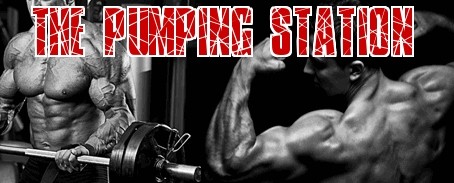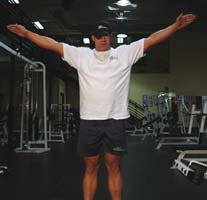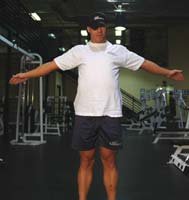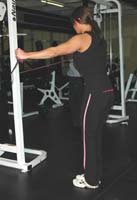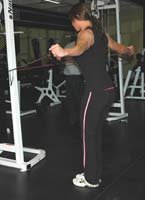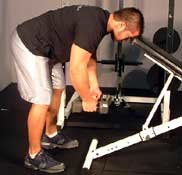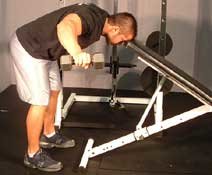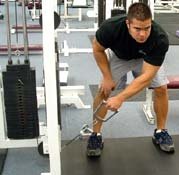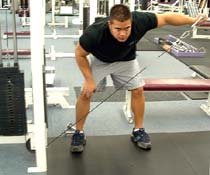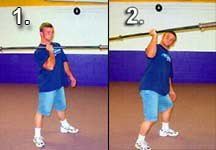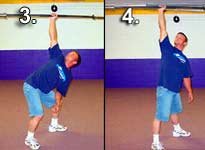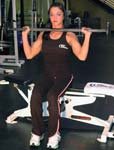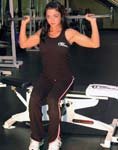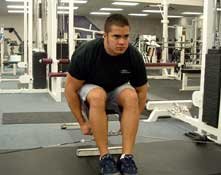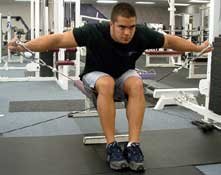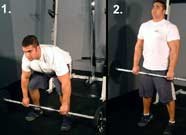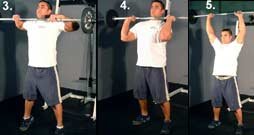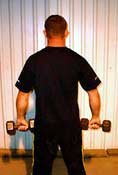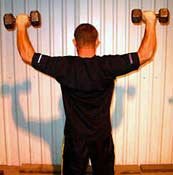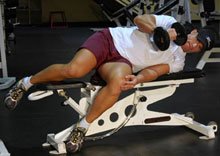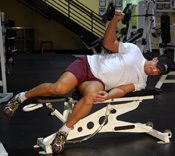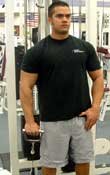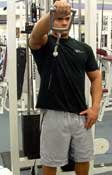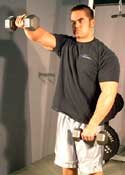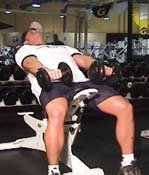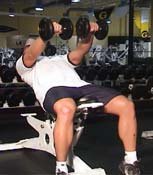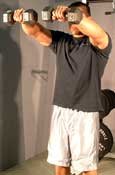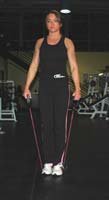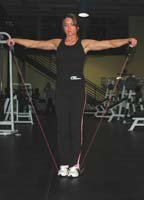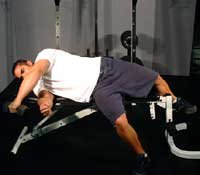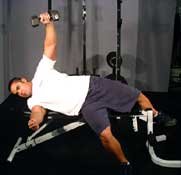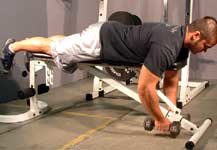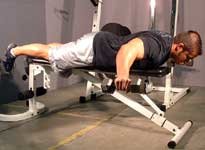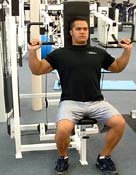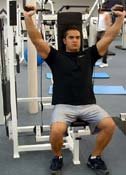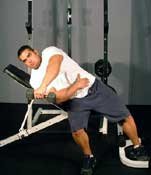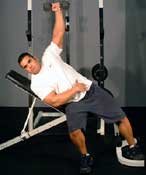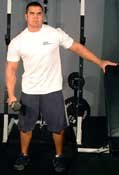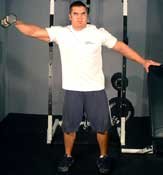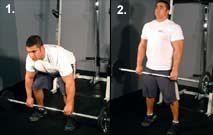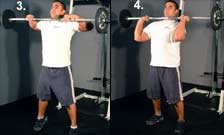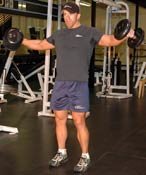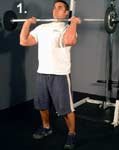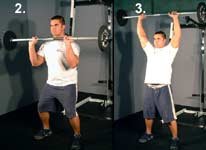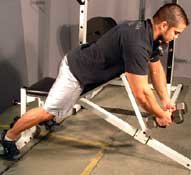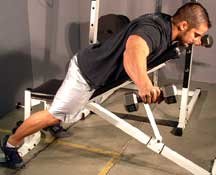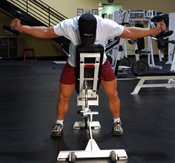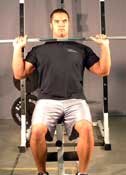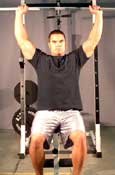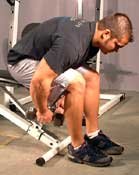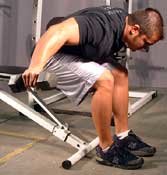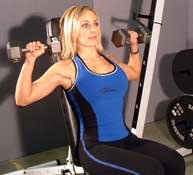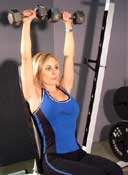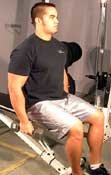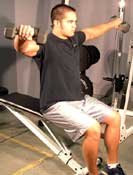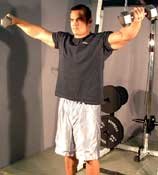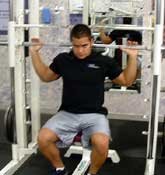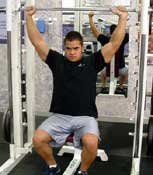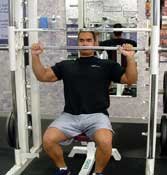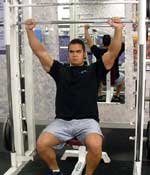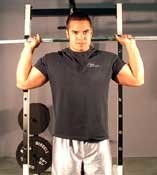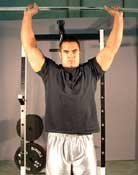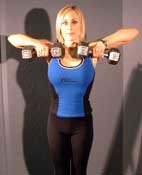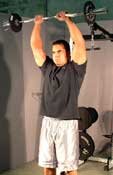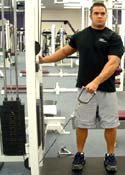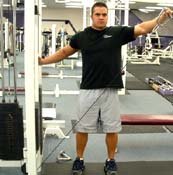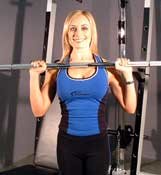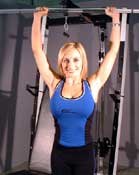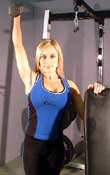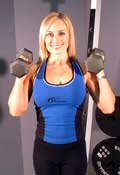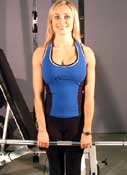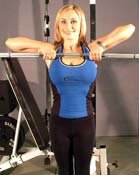Weight Training Shoulders Exercises
Arm Circles
Exercise Data
Main Muscle Worked: Shoulders
Other Muscles Worked: Triceps,Biceps,Lats
Equipment: BodyOnly
Mechanics Type: Compound
Tips: Start with hands straight out by sides. Slowly make circles with each outstretched arm, about one foot in diameter. Continue the circular motion of the outstretched arms for ten seconds.
Arnold Dumbbell Press
Exercise Data
Main Muscle Worked: Shoulders
Other Muscles Worked: Triceps
Equipment: Dumbbell
Mechanics Type: Compound
Tips: Hold two dumbbells in front of you at about upper chest level with your palms facing your body and your elbows flexed. Raise dumbbells by extending elbows; abduct and internally rotate shoulders to straight arm position. Lower to original position and repeat.
Back Flyes - With Bands
Exercise Data
Main Muscle Worked: Shoulders
Other Muscles Worked: Triceps,Middle Back
Equipment: Other
Mechanics Type: Compound
Tips: Fix band around a stationary post. Stand back so that the tension begins with your arms raised in front of you. Keeping your arms straight and feet planted, move your arms back so they are extended to your sides.
Bent Over Dumbbell Rear Delt Raise With Head On Bench
Exercise Data
Main Muscle Worked: Shoulders
Other Muscles Worked: None
Equipment: Dumbbell
Mechanics Type: Isolation
Tips: Rest your forehead on a flat or inclined bench so that you are bent over with your back as close to parallel with the floor as you can. Hold dumbbells with your arms straight down and your elbows locked. Raise the dumbbells out to shoulder height, even with your ears. Do NOT swing the dumbbells up. Keep your body rigid and your head on the bench. Can also be done without the head support.
Bent Over Low-Pulley Side Lateral
Exercise Data
Main Muscle Worked: Shoulders
Other Muscles Worked: Traps
Equipment: Cable
Mechanics Type: Isolation
Tips: Hold the handle with your left hand. Bend until back is nearly parallel to the floor. Your legs should be slightly bent with your right hand on your lower right thigh, left arm hanging from your shoulder. Raise your left arm, elbow locked, until parallel to the floor, in line with your left ear. Lower back to the starting position. After you finish your reps, switch arms and repeat.
Bent Press
Exercise Data
Main Muscle Worked: Shoulders
Other Muscles Worked: Triceps,Lower Back,Quadriceps,Hamstrings,Glutes
Equipment: Barbell
Mechanics Type: Compound
Tips: The bent press is one of the great classic lifts made famous by iron legend Eugene Sandow. It can be performed with either a barbell, dumbbell or kettlebell. Each implement offers its own particular "feel" (read punishment). To perform the bent press, you lift the weight with one hand over your head by slowly "corkscrewing" yourself underneath. It's extremely draining and the lifter needs to really concentrate when performing the movement. In the setup of the lift, position the feet roughly 18 inches apart with the foot on the side that you're holding the weight turned in slightly and the opposite foot turned approximately 90 degree to the side. As the lift begins, the weight is held in such a fashion that it's directly under the hip and you basically turn into it and lower yourself under the bar. As you continue to corkscrew under the bar, your off-side knee bends forward and the opposite knee approaches the ground which assists in stabilizing the balance of the bar. With the arm completely extended, you simply drive off the hip and extend upward. Maintain eye contact with the weight throughout the lift.
Bradford/Rocky Presses
Exercise Data
Main Muscle Worked: Shoulders
Other Muscles Worked: None
Equipment: Barbell
Mechanics Type: Isolation
Tips: Start of the exercise like a military press. Press the barbell to arm's length overhead. Then lower it behind your head to your ears. Press the barbell back to arm's length overhead and lower it to the front. Think of it as alternating between a front press and a behind the neck press. Inhale as you are pressing and exhale as you are lowering the weight. Front and back should be considered one repetition. A little tip for making this a more challenging is to push/raise the bar till a height where it is JUST high enough to clear your head and move it to the back. By not locking out the weight, you're putting the stress on your shoulders and keeping it off your triceps and this provides continuous tension for your delts.
Cable Seated Rear Lateral Raise
Exercise Data
Main Muscle Worked: Shoulders
Other Muscles Worked: None
Equipment: Cable
Mechanics Type: Isolation
Tips: Sit at edge of bench with feet placed beyond knees. Rest torso on thighs. Grasp dumbbell cable attachments with opposite hands. Raise upper arms to sides until shoulder height. Maintain upper arms perpendicular to torso and a fixed elbow position (10° to 30° angle) throughout exercise. Lower and repeat.
Clean And Press
Exercise Data
Main Muscle Worked: Shoulders
Other Muscles Worked: Triceps,Biceps,Lower Back,Traps,Hamstrings,Calves,Abdominals,Shoulders,Glutes
Equipment: Barbell
Mechanics Type: Compound
Tips:
Beginning Position
• Assume a shoulder-width stance, knees inside arms.
• Position feet flat on floor.
• Grasp bar with a closed, pronated grip.
• Grip should be slightly wider than shoulder-width.
• Squat down next to bar, heels on floor.
• Fully extend arms.
• Point elbows out to sides.
• Position bar over the balls of the feet; bar should be close to shins.
• Position shoulders over or slightly ahead of the bar. Establish a flat back posture.
Upward Movement Phase: First Pull
• Begin pull by extending the knees.
• Move hips forward and raise shoulders at the same rate.
• Keep the angle of the back constant.
• Lift bar straight up.
• Keep bar close to the body, heels on the floor.
• Keep elbows fully extended.
• Keep shoulders back and above or slightly in front of the bar.
• Keep head facing straight forward.
• Maintain torso position.
Upward Movement Phase: Transition (Scoop)
• Thrust hips forward and continue pulling until the knees are under the bar.
• Keep feet flat.
• Torso should be nearly vertical and erect.
• Keep shoulders positioned directly over the bar.
• Keep elbows fully extended.
Upward Movement Phase: Second Pull
• Brush bar against the middle or top of thighs.
• Keep torso erect and head facing straight or slightly up.
• Keep elbows straight.
• Move bar explosively by extending the knee, hip, and ankle joints in a "jumping action."
• Keep shoulders over the bar as long as possible, and elbows out.
• Keep bar close to body.
• At maximum plantar flexion, shrug the shoulders.
• At maximum shoulder elevation, flex and pull with the arms
• Keep elbows high during pull; keep them over the wrists.
• Pull bar as high as possible.Catch
• Rotate elbows around and under the bar.
• Hyperextend the wrists as the elbows move under the bar.
• Point elbows forward or slightly up.
• Rack the bar across the front of the shoulders.
• Keep torso erect.
• Flex hips and knees to absorb the weight of the bar.Overhead Press
• Without moving your feet, press the bar overhead.
• The barbell is to be pressed evenly in a continuous movement to arms length overhead.
• During the Press, the trunk may be inclined backwards to any extent, but the legs must remain braced and there must be no movement of the feet.Downward Movement Phase
• Lower bar slowly and under control to top of thighs.
• Flex hips and knees as bar lands on thighs.
• Squat down toward floor.
• Maintain erect torso position.
• Keep bar close to shins.
• Place bar on the floor.Breathing
• Inhale before the first pull of the first repetition.
• Hold breath until second pull.
• Exhale through the sticking point (shrug) of the second pull.
• Inhale during the downward movement phase of succeeding repetitions.
Cuban Press
Exercise Data
Main Muscle Worked: Shoulders
Other Muscles Worked: Middle Back
Equipment: Dumbbell
Mechanics Type: Compound
Tips: From a seated or standing position, hold dumbbells in each hand with your shoulders rotated forward. Commence lift by rotating the shoulders back and pinching the rear delts. Lift weight up such that the shoulder to elbow joint is parallel to the ground and the elbow to wrist is perpendicular.
External Rotation
Exercise Data
Main Muscle Worked: Shoulders
Other Muscles Worked: None
Equipment: Dumbbell
Mechanics Type: Isolation
Tips: This trains the infraspinatus and teres minor muscles which help keep your shoulders safer from injury. Lay down flat on one side on a flat bench. Using a light dumbbell start the exercise with your right arm fully against the right side with the elbow flexed at a 90 degree angle and pinned against the left hip bone. Do not move your upper arm from this position during the exercise. Slowly raise the dumbbell by rotating the right arm upwards while maintaining your 90 degree bend in the elbow. When your lower arm is pointing straight up, lower it down until it is almost touching the bench. Repeat. Do not move your torso during the exercise.
Front Cable Raise
Exercise Data
Main Muscle Worked: Shoulders
Other Muscles Worked: None
Equipment: Cable
Mechanics Type: Isolation
Tips: Works the front delts. Grasp the cable attachment that is attached to the low pulley with one hand. Face away from the pulley and put your arm straight down. Keeping your body straight and your elbow nearly locked, raise your arm up in front of your body. Do not swing! Go up to about eye level, then slowly return to the starting position. Finish your reps and then switch arms.
Front Dumbbell Raise
Exercise Data
Main Muscle Worked: Shoulders
Other Muscles Worked: None
Equipment: Dumbbell
Mechanics Type: Isolation
Tips: Stand with a dumbbell in each hand, palms facing backward. Your feet should be about shoulder width apart. Maintain a slight bend in your elbows throughout the exercise so that your arms are straight, but not quite locked. Lift the weight in your left hand in front of you in a wide arc until it is slightly higher than shoulder height. With a smooth, controlled motion, lower the weight while simutaneously lifting the weight in your right hand, so that both arms are in motion at the same time. Do not cheat by swinging or leaning backwards! Can also be done with two dumbbells at the same time or a barbell.
Front Incline Dumbbell Raise
Exercise Data
Main Muscle Worked: Shoulders
Other Muscles Worked: None
Equipment: Dumbbell
Mechanics Type: Isolation
Tips: Lay down on an incline bench with the incline set anywhere between 30 to 60 degrees. You can change the angle to hit the muscle a little differently each time. Hold two dumbbells with your arms straight and your palms facing down. The dumbbells should start about 1 inch abouve your thighs. Slowly raise the dumbbells straight up until they are slightly above your shoulders, while keeping your elbows locked. Squeeze at the top, then lower them to the starting position and repeat. Keep your head resting down against the bench and your legs on the floor.
Front Plate Raise
Exercise Data
Main Muscle Worked: Shoulders
Other Muscles Worked: None
Equipment: Other
Mechanics Type: Isolation
Tips: Works the front of your shoulders. While standing, hold a barbell plate in both hands at the 3 and 9 o'clock positions. Your palms should be facing each other. Keep your arms straight and locked or nearly locked during the entire exercise. Start with the plate down near your waist as far as you can go, then slowly raise the plate until it is a little above shoulder level. Slowly lower the plate back to the starting position and repeat.
Front Two-Dumbbell Raise
Exercise Data
Main Muscle Worked: Shoulders
Other Muscles Worked: None
Equipment: Dumbbell
Mechanics Type: Isolation
Handstand Push-Ups
Exercise Data
Main Muscle Worked: Shoulders
Other Muscles Worked: Triceps
Equipment: BodyOnly
Mechanics Type: Compound
Tips: Kick yourself up against a stable wall with your arms straight. Make sure that your body is as straight up and down as you can. Keep facing the wall with your head, rather than looking down. Slowly lower yourself to the ground. Once your head almost touches the ground, push yourself back up slowly until your elbows are nearly locked. Repeat. A true test of strength!
Lateral Raise - With Bands
Exercise Data
Main Muscle Worked: Shoulders
Other Muscles Worked: Triceps,Lats
Equipment: Other
Mechanics Type: Compound
Tips: Stand on band so tension begins with arms at sides. Keeping your arms straight, raise you arms out to your sides so they are parallel with the floor.
Lying One-Arm Lateral Raise
Exercise Data
Main Muscle Worked: Shoulders
Other Muscles Worked: Lats
Equipment: Dumbbell
Mechanics Type: Isolation
Tips: Lie on your side on a flat bench with a dumbbell in your uppermost hand. Your shoulders should be perpendicular to the bench. The lower arm should be extended in a comfortable position to act as a counterbalance. Your upper leg should be straight in line with the bench and your lower leg should stretch out to the floor to stabilize yourself. Start by extending the dumbbell out in front of your body and slightly toward the floor. Using your shoulder muscles, raise the weight directly above your body, then lower to the starting position. Finish your reps and then switch sides. Don't use weights that are too heavy or you will not be isolating the shoulder as much.
Lying Rear Delt Raise
Exercise Data
Main Muscle Worked: Shoulders
Other Muscles Worked: None
Equipment: Dumbbell
Mechanics Type: Isolation
Tips: Works your rear delts. Lie face down on a fairly tall flat bench. Hold dumbbells, palms facing in, arms hanging straight down. Keep your elbows almost locked and your arms straight. Raise dumbbells in a semicircular motion to shoulder height, in line with your ears at the top of the lift. Lower slowly to the starting position.
Machine Shoulder (Military) Press
Exercise Data
Main Muscle Worked: Shoulders
Other Muscles Worked: Triceps
Equipment: Machine
Mechanics Type: Compound
Tips: Follow the directions on the shoulder press machine.
One-Arm Incline Lateral Raise
Exercise Data
Main Muscle Worked: Shoulders
Other Muscles Worked: None
Equipment: Dumbbell
Mechanics Type: Isolation
Tips: Sit sideways on a bench and lean one of your shoulders against it. Hold a dumbbell in your uppermost arm. Keeping the dumbbell parallel to the floor at all times, perform a lateral raise. Your arm should travel straight up until it is pointing at the ceiling. Slowly return to the starting position and repeat for your desired number of reps. Switch sides and arms and repeat. You can also do this with a cable or on a flat bench.
One-Arm Side Laterals
Exercise Data
Main Muscle Worked: Shoulders
Other Muscles Worked: None
Equipment: Dumbbell
Mechanics Type: Isolation
Tips: Using one arm at a time, you will be able to handle roughly 30 percent more weight than in the standard two-arm version. Strap the working hand into the dumbbell handle, then hold onto something steady with the other, such as an adjustable incline bench or the uprights of a power rack. Leaning into the working shoulder and away from what you're holding onto, use just a touch of body English to power up the dumbbell until it's level with your shoulder. Attempt to bring it to a full stop, then lower slowly. This exercise is undefeated for slapping on meat onto the all-important side deltoid heads.
Power Clean
Exercise Data
Main Muscle Worked: Shoulders
Other Muscles Worked: Triceps,Middle Back,Lower Back,Traps,Forearms,Quadriceps,Hamstrings,Calves,Shoulders,Glutes
Equipment: Barbell
Mechanics Type: Compound
Tips:
Beginning Position
• Assume a shoulder-width stance, knees inside arms.
• Position feet flat on floor.
• Grasp bar with a closed, pronated grip.
• Grip should be slightly wider than shoulder-width.
• Squat down next to bar, heels on floor.
• Fully extend arms.
• Point elbows out to sides.
• Position bar over the balls of the feet; bar should be close to shins.
• Position shoulders over or slightly ahead of the bar. Establish a flat back posture.
Upward Movement Phase: First Pull
• Begin pull by extending the knees.
• Move hips forward and raise shoulders at the same rate.
• Keep the angle of the back constant.
• Lift bar straight up.
• Keep bar close to the body, heels on the floor.
• Keep elbows fully extended.
• Keep shoulders back and above or slightly in front of the bar.
• Keep head facing straight forward.
• Maintain torso position.
Upward Movement Phase: Transition (Scoop)
• Thrust hips forward and continue pulling until the knees are under the bar.
• Keep feet flat.
• Torso should be nearly vertical and erect.
• Keep shoulders positioned directly over the bar.
• Keep elbows fully extended.
Upward Movement Phase: Second Pull
• Brush bar against the middle or top of thighs.
• Keep torso erect and head facing straight or slightly up.
• Keep elbows straight.
• Move bar explosively by extending the knee, hip, and ankle joints in a "jumping action."
• Keep shoulders over the bar as long as possible, and elbows out.
• Keep bar close to body.
• At maximum plantar flexion, shrug the shoulders.
• At maximum shoulder elevation, flex and pull with the arms
• Keep elbows high during pull; keep them over the wrists.
• Pull bar as high as possible.Catch
• Rotate elbows around and under the bar.
• Hyperextend the wrists as the elbows move under the bar.
• Point elbows forward or slightly up.
• Rack the bar across the front of the shoulders.
• Keep torso erect.
• Flex hips and knees to absorb the weight of the bar.Downward Movement Phase
• Lower bar slowly and under control to top of thighs.
• Flex hips and knees as bar lands on thighs.
• Squat down toward floor.
• Maintain erect torso position.
• Keep bar close to shins.
• Place bar on the floor.Breathing
• Inhale before the first pull of the first repetition.
• Hold breath until second pull.
• Exhale through the sticking point (shrug) of the second pull.
• Inhale during the downward movement phase of succeeding repetitions.
Power Partials
Exercise Data
Main Muscle Worked: Shoulders
Other Muscles Worked: None
Equipment: Dumbbell
Mechanics Type: Isolation
Tips: Stand upright, with your feet about shoulder width apart and your arms to your sides. Hold a dumbbell in each hand, with your palms turned toward your body. Keeping your arms straight, lift the weights out and up to the sides until they are slightly under shoulder level. Then slowly lower them to your sides. It's important to keep your palms turned downward as you lift the dumbbells so that your shoulders, rather than your biceps, do the work. Make sure you lift the dumbbells on the way up rather than "swinging" them up. Don't lean forward! Keep the dumbbells at your sides.
Push Press
Exercise Data
Main Muscle Worked: Shoulders
Other Muscles Worked: Triceps
Equipment: Barbell
Mechanics Type: Compound
Tips:
Beginning Position
• Use the floor-to-shoulder lifting technique described in the Power Clean exercise to move the bar from the floor to the shoulders.Upward Movement Phase
• Slightly flex the hips and knees, keeping torso erect.
• Immediately follow with an explosive push upward by extending the knees.
• Keep torso erect and tensed.
• At maximum hip and knee extension, shift body weight to balls of feet and extend ankle joints.
• At maximum plantar flexion, push bar from the shoulders.
• Push the bar with the arms to a fully extended elbow position overhead.Downward Movement Phase
• Lower bar to shoulders.
• Flex hips and knees slightly as bar touches shoulders.
• Straighten the hips and knees before the upward movement phase begins again.
Breathing
• Exhale through the sticking point of the upward movement phase.
• Inhale during the downward movement phase.
Reverse Flyes
Exercise Data
Main Muscle Worked: Shoulders
Other Muscles Worked: None
Equipment: Dumbbell
Mechanics Type: Isolation
Tips: Works the rear deltoids. Set an incline bench at the lowest possible angle. Then, with a dumbbell in each hand, lie face down on the bench so that the top of the bench is supporting your chest. Extend your arms in front of you so that they are perpendicular to the angle of the bench. Your palms should be facing each other and your elbows should be slightly bent. Maintaining the slight bend in your elbows, lift the weights by pulling your arms apart in an arcing motion. Think about trying to squeeze your shoulder blades together. Continue moving your elbows up until the dumbbells are at either side of your head. Slowly return to the starting position.
Reverse Flyes With External Rotation
Exercise Data
Main Muscle Worked: Shoulders
Other Muscles Worked: Traps
Equipment: Dumbbell
Mechanics Type: Isolation
Tips: This works mainly the rear delts and two of the rotator cuff muscles. This helps to improve the posture, alignment, and function of the shoulder joint. Lie face down on an incline bench that is set at 30 degrees. Hold a dumbbell in each hand with your palms facing your feet and your arms hanging down. Raise the dumbbells toward the ceiling while maintaining a slight bend in your elbows. As you approach the top, begin externally rotating your arms as if you were attempting to make your palms face forward. When you reach the top, hold for a second and then slowly return to the starting position.
Seated Barbell Military Press
Exercise Data
Main Muscle Worked: Shoulders
Other Muscles Worked: Triceps
Equipment: Barbell
Mechanics Type: Compound
Tips: Raise a barbell to your shoulders. Sit at the end of a bench, with your feet at about shoulder width, flat on the floor. Keep your chest high and your back straight. Press bar to arm's length overhead. Use a slow, steady motion, without swinging. Lower slowly to starting position. Can also be done standing or with dumbbells.
Seated Bent Over Rear Delt Raise
Exercise Data
Main Muscle Worked: Shoulders
Other Muscles Worked: None
Equipment: Dumbbell
Mechanics Type: Isolation
Tips: Works your rear delts. Hold two dumbbells and sit at the end of a flat bench with your feet firmly on the floor and fairly close together. Bend forward until your chest nearly touches your thighs. Hang dumbbells between your lower legs and bench. Keep your arms straight and your elbows nearly locked. Raise dumbbells in a semicircular motion until your arms are parallel to the floor, even with your ears. Return slowly to starting position. Do not swing!
Seated Dumbbell Press
Exercise Data
Main Muscle Worked: Shoulders
Other Muscles Worked: Triceps
Equipment: Dumbbell
Mechanics Type: Compound
Tips: Pick up a pair of dumbbells and sit on a shoulder press bench (with a short, straight back) or a regular incline bench adjusted so the back is as straight up as possible. Press your back firmly against the back of the bench with your feet flat on the floor. Hold a dumbbell in each hand, just above shoulder level, with your elbows out and palms facing forward. Press the dumbbells up and in until they nearlytouch above your head. Don't let the weights stray back and forth. Press the weights up until your arms are almost straight (your elbows should be just short of locked). Then slowly lower the dumbbells to the starting position.
Seated Side Lateral Raise
Exercise Data
Main Muscle Worked: Shoulders
Other Muscles Worked: None
Equipment: Dumbbell
Mechanics Type: Isolation
Tips: Works the side delts. Sit at the end of a flat bench with your feet firmly on the floor. Hold dumbbells with your palms facing in and your arms straight down at your sides. Raise dumbbells in a semicircular motion a little above shoulder height. Slowly lower to the starting position using the same path. Do not swing! Keep your arms straight. Can also be done standing.
See-Saw Press (Alternating Side Press)
Exercise Data
Main Muscle Worked: Shoulders
Other Muscles Worked: Triceps,Abdominals
Equipment: Dumbbell
Mechanics Type: Compound
Tips: A seemingly simple exercise that jumps up and bites back at you. The exercise can be performed with virtually any form of resistance so equipment should never be a problem. The movement starts with the weight held at chest/shoulder level and palms facing towards you (like an Arnold Press). As you raise your one hand, twist it inwards while simultaneously bending from your hip to your opposite side. With the weight fully extended and you bent over, begin the movement to the other side. A powerful exercise of yesteryear that will thicken the torso-up. For those who enjoy the side press this will take it to the next level.
Shoulder Press - With Bands
Exercise Data
Main Muscle Worked: Shoulders
Other Muscles Worked: Biceps,Lats
Equipment: Other
Mechanics Type: Compound
Tips: Stand the band so that the tension starts with hands by your shoulders. Hold handles palms forward with bottom part of handle on backside of your hand. Press upward as you would a dumbbell press.
Side Lateral Raise
Exercise Data
Main Muscle Worked: Shoulders
Other Muscles Worked: None
Equipment: Dumbbell
Mechanics Type: Isolation
Tips: Stand upright, with your feet about shoulder width apart and your arms to your sides. Hold a dumbbell in each hand, with your palms turned toward your body. Keeping your arms straight, lift the weights out and up to the sides until they are slightly higher than shoulder level. Then slowly lower them to your sides. It's important to keep your palms turned downward as you lift the dumbbells so that your shoulders, rather than your biceps, do the work. Make sure you lift the dumbbells on the way up rather than "swinging" them up. Don't lean forward! Keep the dumbbells at your sides.
Smith Machine Behind The Neck Press
Exercise Data
Main Muscle Worked: Shoulders
Other Muscles Worked: Triceps
Equipment: Machine
Mechanics Type: Compound
Smith Machine Overhead Shoulder Press
Exercise Data
Main Muscle Worked: Shoulders
Other Muscles Worked: Triceps
Equipment: Machine
Mechanics Type: Compound
Tips: Using a Smith Machine, perform the overhead press just like you would if you were using a barbell. You can also do this behind the neck.
Snatch
Exercise Data
Main Muscle Worked: Shoulders
Other Muscles Worked: Biceps,Lower Back,Traps,Quadriceps,Shoulders,Glutes
Equipment: Barbell
Mechanics Type: Compound
Tips:
Beginning Position
• Assume a shoulder-width or slightly wider stance, knees inside arms.
• Position feet flat on the floor, toes pointed slightly outward.
• Grasp the bar with a pronated closed or hook grip.
• The correct distance between hand placements should
be determined by one of the following methods:
1. Elbow-to-elbow distance when arms are straight out at sides.
2. Distance from the edge of clenched fist of one hand to opposite shoulder when arm is straight out at side.
• Squat down next to the bar, heels on the floor.
• Fully extend arms.
• Point elbows out to sides.
• Position bar over the balls of the feet; bar should be close to shins.
• Position the shoulders over or slightly ahead of the bar.
• Establish a flat back posture by
: : : : : :� Pulling shoulder blades toward each other,
: : : : : :� holding chest up and out, and
: : : : : :� tilting head slightly up.
• Focus eyes ahead or slightly above horizontal. Keep torso tensed.
Upward Movement Phase: First Pull
• Begin pull by extending the knees.
• Move hips forward and raise shoulders at the same rate.
• Keep the angle of the back constant.
• Lift bar straight up.
• Keep bar close to the body, heels on the floor.
• Keep elbows fully extended.
• Keep shoulders back and above or slightly in front of the bar.
• Keep head facing straight forward.
• Maintain torso position.
Upward Movement Phase: Transition (Scoop)
• Thrust hips forward and continue pulling until the knees are under the bar.
• Keep feet flat.
• Torso should be nearly vertical and erect.
• Keep shoulders positioned directly over the bar.
• Keep elbows fully extended.
Upward Movement Phase: Second Pull
• Brush bar against the middle or top of thighs.
• Keep torso erect and head facing straight or slightly up.
• Keep elbows straight.
• Move bar explosively by extending the knee, hip, and ankle joints in a "jumping action."
• Keep shoulders over the bar as long as possible, and elbows out.
• Keep bar close to body.
• At maximum plantar flexion, shrug the shoulders.
• At maximum shoulder elevation, flex and pull with the arms
• Keep elbows high during pull; keep them over the wrists.
• Pull bar as high as possible.Catch
• As the bar reaches maximum height, slightly flex the hips then the knees.
• Flex then rotate elbows around and under the bar. At maximum bar height, fully extend the elbows and hyperextend the wrists to lock bar overhead. Contact floor with feet before the bar is locked overhead.
• Catch bar by flexing at the knees and hips to absorb weight.
• Squat down slowly and under control. Keep torso erect.
• At lowest squat position, the bar should be over the shoulders, hips over the ankles, and the elbows locked.Upward Movement Phase: Recovery
• Once under control in low squat position, slowly extend the hips and knees to move the body to a fully erect, standing position.
• Keep bar locked overhead.Downward Movement Phase
• Follow the downward movement phase of the "Power Clean."Breathing
• Inhale before the first pull of the first repetition.
• Hold breath until the second pull.
• Exhale through the sticking point (shrug) of the second pull.
• Inhale while lowering the body to the low squat position.
• Exhale through the sticking point of the recovery phase.
• Inhale during the downward movement phase of succeeding repetitions.
Standing Barbell Press Behind Neck
Exercise Data
Main Muscle Worked: Shoulders
Other Muscles Worked: Triceps
Equipment: Barbell
Mechanics Type: Compound
Tips: Place a barbell on your upper back. Stand with your feet about shoulder width apart. Keep hands about 4 - 6 inches wider than shoulder width. Press bar overhead to arm's length. Lower slowly back down to your shoulders. Keep your legs straight at all times. Can also be done seated or in front of your neck.
Standing Dumbbell Straight-Arm Front Delt Raise Above Head
Exercise Data
Main Muscle Worked: Shoulders
Other Muscles Worked: None
Equipment: Dumbbell
Mechanics Type: Isolation
Tips: Hold dumbbells in front of your thighs, palms facing in. Keep your arms straight, elbows locked and raise dumbbells in a semicircular motion to arm's length overhead. Return to starting position using the same path. Can also be done one arm at a time or seated.
Standing Dumbbell Upright Row
Exercise Data
Main Muscle Worked: Shoulders
Other Muscles Worked: Biceps,Traps
Equipment: Dumbbell
Mechanics Type: Compound
Tips: Hold dumbbells, hanging, against your upper thighs. Keep dumbbells about 10 inches apart, thumbs facing in. Pull dumbbells straight up until nearly even with your chin. Keep your elbows up and out! Keep weights close to your body and slowly return to the starting position. Can also be done with a cable or barbell.
Standing Front Barbell Raise Over Head
Exercise Data
Main Muscle Worked: Shoulders
Other Muscles Worked: None
Equipment: Barbell
Mechanics Type: Isolation
Tips: Works your front delts. Stand with your feet about shoulder width, with your back straight and hips locked. Use a shoulder width grip. Start with the bar at arm's length against your upper thighs. Raise bar in a semicircular motion until it is directly overhead. Do now unlock elbows. Lower bar slowly back to starting position. Can also be done with two dumbbells or a close or wide grip.
Standing Low-Pulley Deltoid Raise
Exercise Data
Main Muscle Worked: Shoulders
Other Muscles Worked: Traps
Equipment: Cable
Mechanics Type: Isolation
Tips: Works the side delts. Stand with your left side facing a low pulley with a single handle. Hold with your right hand. Stand straight up wth your head up. Your right hand should be in line with your groin area of your left side. Raise the pulley in a semicircular motion, arm straight, elbow locked, until your arm is just above parallel to your right shoulder. Lower to the starting position slowly. Finish your reps, then switch arms.
Standing Military Press
Exercise Data
Main Muscle Worked: Shoulders
Other Muscles Worked: Triceps
Equipment: Barbell
Mechanics Type: Compound
Tips: Raise barbell to your chest with your hands shoulder width apart. Lock your legs and hips. Keep your elbows in, slightly under your bar. Press bar to arm's length overhead. Lower to your upper chest or chin (depending on what is comfortable). Some experts believe lowering the bar to your chest is too low and strains the shoulders too much. Can also be done seated or with dumbbells.
Standing Palm-In One-Arm Dumbbell Press
Exercise Data
Main Muscle Worked: Shoulders
Other Muscles Worked: Triceps
Equipment: Dumbbell
Mechanics Type: Compound
Tips: Raise dumbbell to shoulder height. Hold onto something with your free hand to stabilize yourself (like an incline bench). Lock your legs and hips. Keep your elbow in and your palm in. Press dumbbell straight up to arm's length. Return to starting position. Can be done seated as well.
Standing Palms-In Dumbbell Press
Exercise Data
Main Muscle Worked: Shoulders
Other Muscles Worked: Triceps
Equipment: Dumbbell
Mechanics Type: Compound
Tips: Raise two dumbbells to shoulder height. Lock legs and hips. Keep your elbows in and your palms facing in. Press dumbbells to shoulder height. Return slowly to starting position. Can also be done seated, or with one dumbbell at a time.
Upright Barbell Row
Exercise Data
Main Muscle Worked: Shoulders
Other Muscles Worked: Biceps,Traps
Equipment: Barbell
Mechanics Type: Compound
Tips: Standing upright, grasp a barbell with your hands about shoulder width apart. Let the bar hang straight down in front of you. Keep your body and wrists straight. Pull the bar straight up towards your chin, keeping it close to your body. Concentrate on either pulling with your traps or the front of your shoulders, depending on what you want to work most. Lower slowly to the starting position. Don't cheat by leaning forward or backward. Don't swing!
Click Here to Sign Up for Your Free Bodybuilding Magazine Subscription
